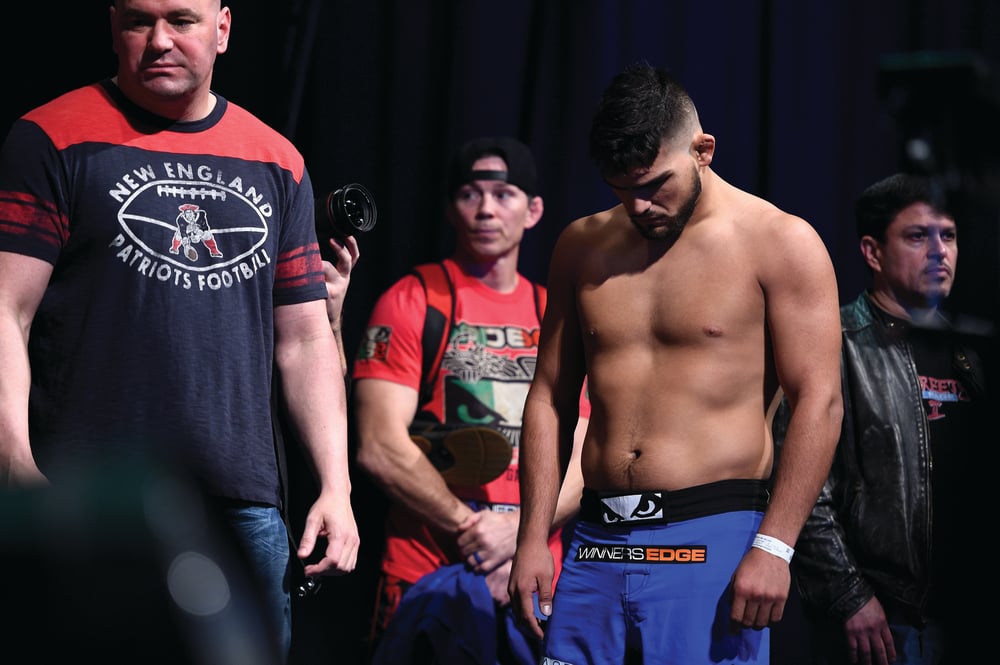
Issue 128
October 2019
MMA’s war against PEDs continues, but the sport’s next great battle, to safeguard athletes against potentially fatal weight-cutting practices, is becoming ever more important. Fighters Only investigates .
Stood in the lobby of the grandest hotel in one of the world’s major cities, a group of men – some gaunt, some seated, others leaning against the wall leading to the exit – form a long line, waiting for the arrival of the bus that will take them to a sports arena. No one is talking. They look exhausted, spent.
When the bus arrives, they shuffle out and disappear into the vehicle, with the air of a gang being led to the gallows. This scene is played out time and time again, at 3pm, on the Friday of fight week. The fighters are heading to the weigh-in. Just 24 hours later, they step in to compete in what is always the fight of their lives.
This is not a scenario concocted via writer’s license. I’ve witnessed this very moment play out perhaps three or four dozen times and the routine looks the same, whether it’s in Mexico City, Chicago, London or Tokyo… and the faces and the feelings are always the same.

Fighters go through physical agony cutting weight, their moods change, and there is often great concern from their teams. This is not an exaggerated view. Behind the scenes, trainers and teammates will often whisper in hotel corridors that the man entering the arena on Saturday night is “having a difficult weight cut.”
I’ve heard this too many times. So many times, in fact, that it has become an accepted, yet unnecessary ‘norm’ and practice in mixed martial arts.
Nowhere is it worse than at the top of the food chain, and that means in the UFC. Far too many fighters cut too much weight, too quickly, for the perceived advantage of being a bigger man in a lighter weight division.
There are statistics, moreover, to back up the fact that doing this does not necessarily guarantee victory. A study by the New Jersey Athletic Control Board found the advantages of being the bigger fighter are, statistically, not anywhere close to what people think. Just 52% of fighters who gained the most weight after weigh-in won their fight.
The issue of weight cutting is nothing new. It’s become so old, in fact, it’s now almost overlooked. It’s also an issue both within and outside of MMA. Amateur wrestling has a long history of athletes dropping too much weight while boxers can gain 15lb between weigh-ins and championship bouts.
Weight-cutting comes down to trial and error. Rapid weight-loss is part of the athletic life for fighters, wrestlers and jockeys. Some cut corners. Some don't. But often, there is little or no medical supervision. It’s a dangerous practice, and needs guidelines and close attention from the authorities.
Fighters Only has spoken with medical experts; doctors, a consultant neurosurgeon and regulatory officials. They agree that the methods being used to do this means that athletes are putting their lives at risk, with ‘dangerous’ rapid weight cuts in a sport that is inherently dangerous anyway.
Even MMA's leading head coaches believe it's an outdated practice that needs to change. Make no mistake, weight cutting is the greatest problem in the sport outside PEDs. And it needs tackling.
HIGH RISK, LOW REWARD
The bottom line is dropping large amounts of weight can wreak havoc on the human body. There have been multiple cases of tragedy and serious illness from crashing weight loss already in MMA.
The worst of these was in September 2013, with the death of Leandro Souza. The Nova Uniao fighter was found dead in a sauna after trying to cut from 159lb to the flyweight limit of 126lb in less than a week for the Shooto 43 show in Brazil. He was 26 years old.
By some accounts, Souza was using diuretics in order to lose 23% of his body weight in fewer than seven days. Ask any medical expert what they think of that.
Other cases are even more prominent in recent times. Renan Barao, the former UFC bantamweight champion, passed out and was hospitalized the night before his headline fight against TJ Dillashaw last summer at UFC 177.
He was in the bath, got light-headed and fell. Outside the obvious physical calamity, and sickness, it cost him his rematch with Dillashaw and his standing within the company. But this is not unusual.
The past few years have thrown up obvious examples. Irishman Paul Redmond, a career lightweight, was signed by the UFC for a featherweight fight at UFC on Fox 15 in Stockholm. He was given two weeks notice, despite weighing 182lb on the day the offer was made.
That meant he had 13 days to lose 36lb. He failed to make weight, was lethargic in the fight, and unsurprisingly, appeared out of his depth. His debut was a disaster, but should he have been fighting at all?
Holly Holm, five-foot-eight and a former UFC bantamweight champion, cuts 20lb to fight. She often uses the sauna, she has admitted. Medics strongly advise against this unscientific method of 'boiling down'. Rapid weight loss for women has serious repercussions.
Fat cells produce estrogen, which maintains a healthy bone density and strength, and rapid weight loss can moreover disrupt women's menstrual cycles, explained one doctor.
Fine in the short term, bad in the long term. Holm, 37, says she’s been doing it for so long as a boxer/kickboxer, she’s just attuned to the grind.

The result of consistent weight cuts can be more than physical, too. Another former women’s bantamweight champion Ronda Rousey admitted in one interview how dropping weight played a part in her developing bulimia.
There are others: kidney failure for TJ Cook, a Strikeforce fighter, after weight-cutting. Ditto Daniel Cormier as he cut to 211.5lb for the 2008 Beijing Olympics. 'DC' was forced out of competing at the Games with his life at risk.
Even the early seasons of The Ultimate Fighter detailed debilitating weight cuts, and what fighters force themselves through. Now they have largely gone, air-brushed out. But the problem remains.
One of the most worrying cases in relatively recent times was Kelvin Gastelum. At UFC 183 in January 2015, Gastelum weighed in at 180lb, 9lb over the welterweight limit, to face Tyron Woodley. He had been hospitalized 24 hours earlier. He still fought on the Saturday night.
Gastelum had been a few pounds off the welterweight limit 24 hours before the weigh-in when he became “non-responsive” and began vomiting mucus, as related by his head coach Chance Farrar, a former fighter himself. They ended up in the emergency room, where he was immediately rehydrated.
Gastelum fought, but was told by the UFC that he would be a middleweight forever more. Just as they did with John Lineker, a powerfully-built ‘flyweight’ who failed several times to make it down to 125lb. He's now a bantamweight.
Perhaps UFC officials should be more stringent with this and have a zero-tolerance policy. It might help everyone. But then again, it may force fighters to cut weight harder. It's a delicate conundrum.
But these are the warning signs not just for individuals, but the sport itself. And judging by the comments from many fighters and their coaches, it’s merely the tip of the iceberg.

TAKING ACTION
The problems associated with extreme weight cutting involve body fluid and hydration. MMA is a striking sport, so there are medical issues going into combat less than fully rehydrated.
Many of the weight-cutting practices come from a variety of fields, notably bodybuilding and wrestling. But they are not ‘fight’ sports, where the combatants take blows to the head. Removing the fluid from the brain makes it far more susceptible to damage, which is what should be the biggest long-term concern in MMA. That's the big argument against same-day weigh-ins, for example.
The dangers are clear yet policing it is a grey area, with no ready solution. Could there be benefits in introducing pre-fight weigh-ins for events, for example?
Fighters Only discussed several alternatives to tackle the issue. One option could be Skype weigh-ins to the UFC office from gyms worldwide on certain check dates ahead of events. Another could be medical checks to ascertain weight guidelines based around a system addressing body types. Most sources contacted believed it may be impossible, or too irregular, to police or monitor.
One fast solution could be to create more weight classes, but that is unlikely, believes Marc Ratner, the UFC’s VP of regulatory affairs.
Rehydration tests could also be implemented, but it could be long-winded and costly for the commissions. It would also provide another means, if fighters failed them, for contests to be cancelled.
Something needs to be done, responsibility created, and if the UFC threw its weight behind it, like it has so openly addressed PEDs, its actions could create a landslide to inspire the rest of the sport.
The consensus gained by Fighters Only is that it needs to be an educational process for the fighters themselves. That is where, of course, the responsibility starts.
The World Boxing Council (WBC), one of boxing's leading independent world governing bodies, has invested a million dollars with researchers at the Brain Injury Research Programme at UCLA over the last two decades, and made changes to its code for weigh-ins as a result of the UCLA lab findings.
Mauricio Sulaiman, president of the WBC, explains to Fighters Only: “Weight-cutting and concussions affect the brain. We know this from continuous medical studies. That’s why our title fights were changed from 15 to 12 rounds. Also, we eradicated the ‘same day weigh-in’, and made it 24 hours before.”
That baseline also applies to mixed martial arts. But in a fast-evolving sport, athletes are desperate to make a mark, and fighters shrinking in weight is now a science using every, and any, method they can find.
“It's very dangerous,” added Sulaiman. “We implemented a mandatory 30-day and seven-day weigh-in in order to monitor that fighters are not losing too much weight or too much weight too quickly in a short period of time.”
Advice from the medical practitioners Fighters Only spoke to is clear: rapid weight loss and dehydration carries inherent dangers.
Peter Hamlyn, a consultant neurosurgeon for 20 years at London’s elite training centres for medical practice – Saint Bartholomew’s Hospital and The Royal London Hospital – has operated on several sportsmen who have suffered brain injuries.
Dr Hamlyn stressed two things when asked his opinion about rapid weight loss: “It puts the athlete at more risk of brain injury because they are dehydrated, and secondly, it will have an adverse affect on their fitness in the contest due to the stresses the body has been under. It’s a dangerous practice.”
He added that dehydration should be seriously looked at because it only compounds what he described as “the inherent traumas the brain suffers with exponents in combat and contact sports”.
Research has found that the body can produce one pint of encephalic fluid every 24 hours. That's the fluid that’s within the head, forming a cushion between the brain and the skull. If an athlete dehydrates, that fluid diminishes in synch, making the 24 hours before fight time vital for the body to replenish the pint of liquid in the brain.
Hamlyn re-iterated that athletes should be “made acutely aware through education” of the risks they take by being dehydrated.

EDUCATION FIRST
Back to Ratner, head of regulatory affairs at the UFC. He knows the issues well after three decades’ experience with the UFC, and prior to that with the Nevada State Athletic Commission.
Does one of the doyens of regulation believe weight-cutting is as important an issue as the PED purge which has been implemented?
“Yes, wholeheartedly. I agree completely that it is a very serious issue,” Ratner tells Fighters Only. “Obviously, guys are trying to fight at a lower weight than they should be, I know it’s a problem. We’ve had some guys who have been sick and couldn’t make weight. We're looking at it and right now we don’t know the answer.
“I’ve spoken to doctors about it. This is not a new problem. I’m very aware of it, we are having discussions about it, and I’m not sure how we can make it better other than saying they have to come in at a certain weight on the week of the fight. It’s not ideal.”
Skype-style weigh-ins a month out, he said, may be problematic: “I’m not really sure how accurate the WBC pre-weigh-in is, but we’ve got fighters all over the world and to be able to do it, I’m not really sure if it is practicable. But it is a problem we have to keep looking at it and do something about it.”
Just as in the case with PEDs, nonetheless, Ratner believes education of the athletes must be a baseline in the strategy.
“Education about weight cutting and drugs is vital. It never stops. You’ve really got to look at it, and keep striving for a solution.”
Two doctors contacted by Fighters Only, who work closely with combat sports in the UK and the USA, but preferred to speak off the record, concur on several things.
“The fighters who cut a lot of weight hit a wall at a certain point in the fight,” explains the US physician.
“But the mentality towards weight-cutting in MMA comes more likely from amateur wrestling. As a rule the participants cut far more. In MMA, you could implement weight checks in advance, but there would be cases of extreme weight cuts for those, too. You could end up with fighters cutting weight three times. That would probably be worse.”
The UK MD, prominent in fight sports, believes the greatest need is for a culture change, instead of “looking to shrink from the inside out.”
Both have serious concerns about current practices by fighters.
They also believe, like neurosurgeon Hamlyn, that weight loss should be more fat and mass, less fluid and gradually tapered through a training camp. It makes sense, of course.
Several coaches from leading gyms agreed with that medical theorem. But putting it into practise is another thing. It needs all, not some, to follow the code.

Chance Farrar, Gastelum’s coach, says: “I never want Kelvin to go through a weight cut like that again. However, I do believe that he belongs at 185lb. It's a tough lesson to push the limits of a cut and fail as he did.
“It's a great reminder that the sport is a lifestyle of training and nutrition and a professional doesn't allow his weight to drastically fluctuate. The extreme athletes will always push those limits until time and consequence catch up to them. Is it dangerous? Yes, but how to prevent it is an entirely different discussion.
“Because the fighters can have many fights in a year, the potential for damage is greater if the necessary lifestyle is not adhered to. But I think early monitoring from the organization wouldn't necessarily change anything. There are ways around that. Breaking the tradition of the night before weigh-in is what would change everything.”
But how much can the commissions, UFC, and other MMA organizations really do? The reality may be that there’s not much, other than increased education about the physiological dangers of rapid, large weight cuts.
“Education is needed and it should come sooner rather than later,” neurosurgeon Hamlyn adds, noting that it should be “down to the individual athletes to be responsible and the sport’s leaders to be collectively responsible.”
Right now, what's clear is that everyone does it because everyone else does it. And it's time for that to change. Before the sport faces any more tragedies.

ARE DANGEROUS WEIGHT-CUTTING PRACTICES GAMBLING WITH MMA'S FUTURE?
The average main card fighter in top-level MMA cuts between 10lb-12lb in the final 24 hours of a weight cut. However, it’s not unusual to have athletes cutting 20lb or more. FO explains the following extreme weight-cutting techniques and the dangers associated with them and rapid weight loss:
Water loading
The tactic is excessive drinking of water, then zero water intake to force excessive expulsion prior to getting weighed. Yet water loading can lead to serum electrolyte imbalance and cardiac arrest.
Salt bath cutting & hot-tub sauna-towel wrapping
These techniques also bring risks too, as they shrink the body of its fluids, and draw out toxins at an alarming rate.
Intravenous recovery
Look at the US Anti-Doping Agency (USADA) literature on this which is unequivocal: “Some reports suggest that administration of IV infusions, including supplement and vitamin cocktails, are being provided to athletes for recuperation. This practice is prohibited at all times without prior TUE approval.
WADA has justified the inclusion of IV infusions on the prohibited list given the intent of some athletes to manipulate their plasma volume levels in order to mask the use of a prohibited substance and/or to distort the values in the Athlete Biological Passport. Further, it must be clearly stated that the use of IV fluid replacement following exercise to correct mild rehydration is not clinically indicated nor substantiated by the medical literature. There is a well-established body of scientific opinion to confirm that oral rehydration is the preferred therapeutic choice.”
Distilled water consumption
There’s some controversy surrounding the drinking of distilled water and its safety, benefits and possible consequences. Distilled water is water that’s been boiled down and re-formed without toxins, minerals or excess substances. Bodybuilders and stage figure competitors often use distilled water because of its association with weight loss by water depletion and its effect on flushing out toxins. Its effects have not been clinically tested, and while some bodybuilders affirm its effectiveness, others don’t.
Sodium depletion
Restricting sodium is less likely to cause serious harm to performance and health than fasting. Sodium is associated with water retention. When sodium is consumed in food nearly 100% is absorbed. Water will also be temporarily retained until the body can re-establish sodium and water balance by excreting excess sodium and water in the urine.
DANGERS OF RAPID WEIGHT LOSS
A host of physiological changes occur in the body as a result of ‘drying out’...
• The circulating fluid in the blood vessels shrinks and impacts on the organs.
• Shrinkage of the brain can occur due to dehydration, which can lead to co-ordination problems, delirium and confusion.
• Rapid dehydration can lead to renal failure, or simply the loss of kidney function.
• When the kidneys go into failure, toxins and waste products cannot be excreted. Waste product builds up in the blood, which would lead to dialysis.
• With less volume of fluid in the body, it can lead to a faster heart rate, and low blood pressure.
...









